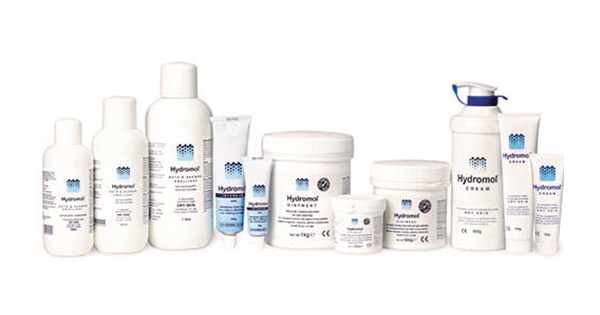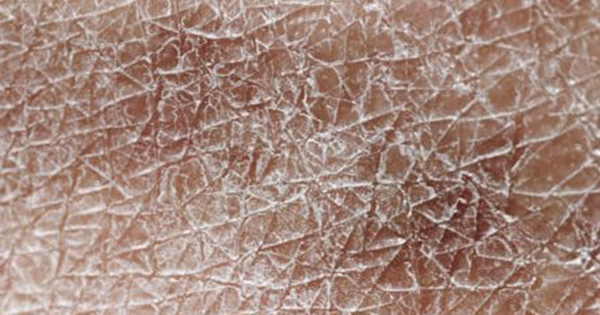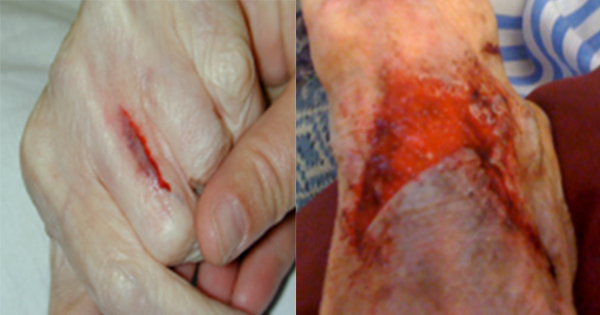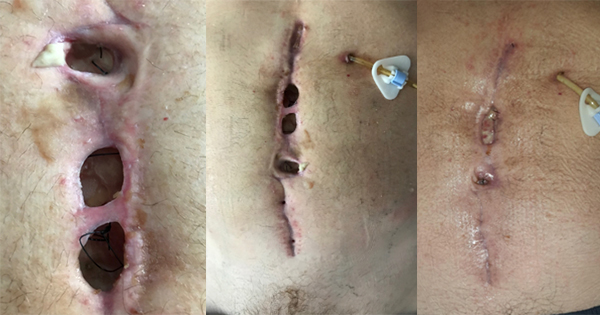This meeting report is based on a ‘Made Easy’ workshop that took place at the Wounds UK Annual Conference in Harrogate, on 12th November 2024. The workshop and meeting report were sponsored by an educational grant from Alliance Pharma.
The workshop was opened by Dr Leanne Atkin (Vascular Nurse Consultant/Research Fellow) and Heather Hodgson (Lead Nurse Tissue Viability), who outlined the session’s learning objectives:
- Understanding the best times to apply emollients to improve patient care
- Exploring the scientific principles behind emollient use, particularly their effects on skin barrier function and hydration
- Building confidence in selecting and using emollients for different patient needs
- Linking theory to practice.
Background and physiology
To identify the importance of using emollients, it is essential to understand the functions and structure of the skin [Figure 1]. It provides:
- Sensory perception and communication (touch).
- A protective barrier against chemical, physical and mechanical hazards.
- Defence from infection, microorganisms and allergens (Proksch et al, 2008; Wounds UK, 2018).
- Temperature regulation.
- Maintenance of hydration and moisture levels.
- Production of vitamin D and melanin (Wounds UK, 2018).
Although the epidermis is the thinnest layer, it plays an important role in maintaining overall skin health. It is responsible for hydration, producing new skin cells, providing protection and determining skin colour. The stratum corneum (outermost layer of the epidermis) retains water to keep the skin hydrated and healthy. New skin cells are continuously produced in the stratum basale, a single-cell-thick layer at the base of the epidermis. These cells migrate upwards through the epidermis, with the skin shedding approximately every 21–28 days (Lawton, 2019).
The skin barrier
The skin barrier is important in protecting the body from external irritants and allergens while preventing excessive water loss. This barrier is primarily made up of the stratum corneum, which consists of dead or dying skin cells (corneocytes) that have lost their nucleus.
A healthy skin barrier
A healthy skin barrier requires the right balance of moisture and lipids. Moisture levels are maintained by corneocytes, which must remain hydrated and swollen. When this occurs, there are no gaps between the cells, creating an intact, seamless protective barrier against irritants and allergens.
Within corneocytes are natural moisturising factors (NMFs). NMFs are humectants that help retain moisture by drawing water into the skin. These naturally occurring substances are produced by the epidermis and are responsible for hydrating the stratum corneum, maintaining skin barrier homeostasis, and supporting skin flexibility. High levels of NMFs are essential for keeping corneocytes plump and hydrated, the stratum corneum pliable and elastic, and for preventing fissures and cracks by ensuring there are no gaps between cells (Cork, 1997; Holden et al, 2002; Box 1).
In addition, between corneocytes lies a complex mixture of lipids and proteins (Cork, 1997). These intercellular lipids are broken down by enzymes from keratinocytes to produce a lipid mixture of ceramides (phospholipids), fatty acids and cholesterol. These molecules are arranged in a highly organised structure, fusing with each other and the corneocytes to form the skin’s lipid barrier, which prevents water loss and the penetration of allergens and irritants (Holden et al, 2002).
To visualise this structure, the skin barrier can be imagined as a brick wall, where corneocytes act as the bricks and the lipid lamellae represent the mortar between the bricks (Cork et al, 1997; Moncrieff et al, 2015; Figure 2). In healthy skin, this combination of “bricks and mortar” in the right balance prevents excessive moisture loss and protects against increased skin permeability.
When the lipid layer is compromised, the skin becomes more prone to dryness, irritation, and damage from external factors.
Understanding skin frailty
While skin frailty is often associated with ageing, it is important to recognise that it is not exclusive to older or very young individuals, and extends beyond traditional age-related concerns (Beeckman et al, 2020). With this in mind, Leanne encouraged the audience to reflect on whether any patients under their care were truly free from the risk of compromised skin integrity. She highlighted the importance of adopting a proactive, preventative approach to skin care for all patient groups.
Examples of at-risk patients may include (Wounds UK, 2018):
- Patients with skin conditions or other comorbidities, such as diabetes.
- Patients with autoimmune disorders
- Critically ill patients.
- Infants and neonates.
- Patients with paralysis
- Bariatric patients.
- Oncology patients.
Compromised skin integrity is associated with complications such as infections, skin tears, pressure ulcers and moisture-associated skin damage (Beeckman et al, 2020). These complications not only cause discomfort but also reduce mobility and quality of life, and increase health risks and healthcare costs.
Dry skin and eczema
When the skin’s natural balance is disrupted, it can lead to a breakdown in the skin’s protective barrier, increasing the likelihood of complications. Specifically, a lack of proper hydration, particularly in individuals with dry skin, can cause further deterioration. This breakdown allows irritants and pathogens to penetrate the skin, exacerbating the condition and leading to the development of the itch-scratch cycle (Cork and Danby, 2009; Mack and Kim, 2018; Figure 3).
The cycle begins when itching prompts scratching, which provides temporary relief but worsens the inflammation, increasing the urge to scratch again. Persistent itching associated with dry skin can lead to sleep disruption and further skin damage from scratching, significantly impacting a patient’s quality of life and exacerbating the condition.
Leanne gave an example of someone with an insect bite on their leg. The initial itch triggers scratching, which releases pro-inflammatory mediators, worsening the inflammation and increasing the desire to scratch. Simply advising patients to stop scratching is often ineffective, as the itch is both overwhelming and self-perpetuating. This cycle is equally strong in patients with eczema and other skin conditions. This underscores the need for a more comprehensive approach to managing eczema, which includes emollient use to break the cycle and protect the skin from further damage.
Eczema (atopic dermatitis) is a chronic inflammatory skin condition that affects up to 20% of children and 3% of adults worldwide (Nutten, 2015). In individuals with eczema, the skin loses its ability to retain moisture due to a reduction in NMFs, which disrupts the lipid lamellae. This leads to a reduction in water content within the corneocytes, causing them to shrink and create gaps between cells. These gaps allow irritants and allergens to penetrate the skin.
The breakdown of the skin barrier also triggers the release of pro-inflammatory cytokines, which further increase inflammation in the stratum corneum. This process initiates a cycle of ongoing skin damage, resulting in extremely dry skin that becomes highly vulnerable to external irritants, such as soaps.
Complications of eczema may include itching, pain, exudate, infections (such as Staphylococcus aureus or fungal infections), permanent skin discolouration, an increased likelihood of contact dermatitis, and ultimately, skin breakdown leading to ulceration.
It is important to recognise that dry skin may present differently across various skin tones. For example, while redness can be an obvious symptom in individuals with less deeply pigmented skin, where it contrasts clearly against lighter skin tones, this is not always the case for those with dark skin tones, such as black, brown or olive (Wounds UK, 2021).
Eczema and venous disease
Eczema can affect various areas of the body, including the lower extremities. In individuals with venous leg ulcers, it may present as venous eczema (also known as varicose, gravitational or stasis eczema), which is more common in elderly patients. It is characterised by red, itchy, scaly or flaky skin, which may have blisters and crusts on the surface. If left untreated, the skin can break down and form ulcers.
Approximately 44% of patients with leg ulcers also have a diagnosis of venous eczema (Patel et al, 2001). Venous eczema may be present on the lower leg with or without the presence of ulceration and can act as a precursor to venous ulceration. Therefore, it should be identified at an early stage by healthcare professionals to ensure preventative treatments are in place (Hoffman, 2010).
Management strategies for a person with venous skin changes include:
- Compression therapy (after excluding arterial insufficiency).
- Regular emollient use on intact skin
- Topical preparations (e.g. topical zinc/calamine).
- Oral antihistamines to stop the itch.
- Corticosteroids (severe cases only/short course.
- Mild topical steroids (e.g. hydrocortisone).
- Moderate topical steroids (e.g. Betnovate™).
- Potent topical steroids (e.g. Dermovate™).
- Topical steroids
If you are a practitioner who uses steroids in your practice, Leanne emphasised the importance of following evidence-based guidelines, such as the Greater Manchester Medicines Management Group’s (2019) steroid ladder [Figure 4]. While topical steroids are effective, caution is always needed due to the potential impact of long-term use, including adrenal suppression (Dhar et al, 2014) and skin thinning (Abraham and Roga, 2014). Many treatment pathways recommend ‘short-term use,’ but the definition of short term is often unclear – whether it refers to 2 weeks or months. A recent review by Lax et al (2024) found no evidence of skin thinning with short-term topical steroid use (in this review, short term was defined as up to 16 weeks).
Regardless of the management strategy used, emollients should always be incorporated into the treatment plan.
Emollients
Emollients are non-cosmetic moisturisers that are an essential component in the management and treatment of dry, itchy or scaly skin conditions. They are applied to the skin to smooth and soften dry, fragile skin, restore the skin’s barrier function and increase hydration (Wounds UK, 2018).
Emollients help repair the lipids in the skin’s outer layer to strengthen the skin barrier. This barrier repair helps replenish NMFs, prevent allergens, irritants and bacteria from penetrating the skin, reduces redness, itching and flaky skin, and ultimately breaks the itch-scratch cycle by preventing the release of inflammatory active proteins.
Simple emollients work by “trapping” moisture in the skin by forming a hydrophobic oil layer on the surface, which slows down and prevents transepidermal water loss (TEWL; Wounds UK, 2018).
Emollients with humectant properties, such as those containing hygroscopic ingredients like sodium PCA, work by binding water molecules in the stratum corneum (Wounds UK, 2018).
Emollients should be seen as a vital part of daily skin care, particularly for individuals with fragile or aged skin, or those who have, or are at increased risk of, developing a wound (Beeckman et al, 2020).
A cluster randomised controlled trial evaluated the effectiveness of a twice-daily moisturising regimen compared to ‘usual’ skin care for reducing skin tear incidence in an aged care facility (Carville et al, 2014). This Australian trial found that the application of a commercially available, standardised pH-neutral, perfume-free moisturiser on the extremities twice daily, reduced the incidence of skin tears by almost 50%.
A separate study introduced the application of pH-friendly (pH 4.5–6.5), non-perfumed moisturiser to the extremities in patients aged 65 or older with at-risk skin. The study also found a reduction in the incidence of skin tears (Finch et al, 2018). Care staff applied the moisturiser twice daily in patients in patients that required assistance. Where possible, patients or their relatives were provided with education on application techniques and encouraged to apply the moisturiser themselves. The time of application was recorded with each use, emphasising the importance of consistency. This relatively low-cost intervention not only reduced skin tear incidence but also improved care outcomes and reduced overall costs.
Other studies have highlighted additional benefits. For example, Moncrieff et al (2018) found that prescribing emollient therapy for atopic eczema in children and adults within UK primary care can be cost-effective, reducing the need for primary care visits, lowering hospitalisation rates, and ultimately decreasing overall healthcare costs.
Types of emollients
Not all emollients are the same, and they can be categorised based on their functions and ingredients:
- Neutral (Occlusive): These form a barrier over the skin to inhibit TEWL.
- Active (Occlusive Plus): These combine the occlusive properties with active ingredients that provide additional benefits, such as anti-inflammatory or antimicrobial effects.
- Emollient Plus: These serve as vehicles for additional active or medicated ingredients, offering therapeutic benefits beyond simple moisturisation.
Forms of emollients
Emollients are available in a variety of forms, including ointments, creams, lotions, bath oils, and soap substitutes. They can often be considered to exist on a continuum, with products that are thicker and greasier (high lipid-to-water ratio) at one end, and products that are less greasy and more water-based (low lipid-to-water ratio) at the other.
- Ointment (severe dry skin): The thickest and greasiest form. Ointments help retain moisture in the skin, making them ideal for treating dry skin, particularly in cooler weather. They contain little to no water and are mostly composed of oils or fats, which absorb slowly into the skin. Due to their greasy nature, ointments may transfer onto clothing or bedding, so they are often used at night when the patient is less active. While some patients find ointments less cosmetically acceptable due to their thickness, they are highly effective in trapping moisture and creating a skin barrier. Ointments are best for people who stay at home or are immobile, as they require less frequent application.
- Cream (moderate dry skin): Lighter in texture (oil emulsified in water), making them easy to absorb and less likely to stain clothes. They are ideal for daytime use or warmer weather because they do not trap heat or clog pores, making them more cosmetically acceptable.
- Lotion (mild dry skin): Contain the least amount of lipids and are mostly water-based, so they are thinner, less greasy and less effective at moisturising the skin. They are useful for hairy areas such as scalps, areas of weepy skin, or if time is short and quick absorption is needed.
- Bath additive: Added to bath water in place of traditional soaps, these moisturise the skin and reduce the drying effects commonly associated with soap and water.
Complete emollient therapy
Complete emollient therapy (CET) is a structured regimen designed to keep a patient’s skin properly moisturised at all times. It involves using a combination of emollients, such as ointments, creams, bath additives and soap substitutes. The goal is to maintain skin hydration and prevent dryness by consistently replenishing moisture throughout the day. CET is defined as “everything that goes on the skin should be emollient-based, and all soaps should be replaced with emollient wash products” (Cork, 1997). Products should be applied liberally and frequently.
Importance of patient choice
Engagement with topical treatments, particularly for dry skin conditions, is often low. This may be due to several factors, including insufficient medical or nursing support in product selection, product attributes, method of application, and the sensory experience of the product on the skin.
Therefore, when choosing an emollient for a patient, it is important to consider the severity of their condition, preferences and lifestyle. Thick formulations, such as ointments, are effective for severely dry areas like the limbs or soles but may be less suitable for facial use or daytime application. Lighter creams are often more acceptable for these situations
Packaging also matters. Patients with limited dexterity may benefit from easy-to-use options like pump dispensers, while portable tubes may be more suitable for those who are frequently on the move.
Selecting an emollient requires balancing patient acceptability with therapeutic benefits.
Hydromol in practice:
Hydromol is a range of emollients, designed to treat dry skin, eczema and ichthyosis. The range includes different products tailored for various indications, as outlined in Table 1.
Emollient fire risk
An important safety consideration when using emollients is their flammability risk. Scientific testing shows that fabrics, including clothing, towels, bandages and bedding, can burn more quickly and intensely when contaminated with emollients. This risk is associated not only with paraffin-containing emollients but also with those made from natural oils or containing other flammable constituents (Medicines and Healthcare Products Regulatory Agency, n.d.).
Healthcare practitioners must provide patients and carers with information regarding the potential fire risk associated with emollients, along with guidance on safe handling and storage practices.
Building confidence in selecting and applying emollients
Heather Hodson concluded the workshop by introducing the EMOLLIENTS acronym, which was designed to guide healthcare practitioners in selecting and applying emollients to meet patient needs:
- Every patient should be assessed for the need of an emollient, particularly those with frail skin, skin conditions or comorbidities that affect healing (Marshall et al, 2022)
- Make moisturising an integral part of person-centred care (Cork and Danby, 2009). CET should replace soaps and detergents, incorporating creams, ointments and wash products
- Organ care. The skin, the body’s largest organ, plays a vital role in health. Maintaining skin integrity is essential
- Look closely. Daily skin inspection is fundamental to identifying early signs of damage, regardless of age or skin condition
- Listen to patients. Cosmetic acceptability matters. Patients are more likely to use emollients they find comfortable
- Integrity of skin. Skin becomes more vulnerable due to ageing, environmental damage, or underlying conditions. Maintaining integrity supports health and function (Marshall et al, 2022)
- Evidence-based practice. Emollient therapy is supported by extensive evidence and should inform clinical decisions
- NMC Code Compliance. Emollient therapy aligns with multiple clauses of the Nursing and Midwifery Council Code (2019)
- Timely intervention. Early prescribing and application of emollients optimise therapeutic outcomes (Bratsos et al, 2014)
- Skin care routine. Regular skin care should be a fundamental part of daily practice.
Key messages
The ‘Made Easy’ workshop provided a clear understanding of emollients and highlighted that, most importantly, patient comfort is paramount. The most effective emollient is one that is applied regularly. Patient involvement in the decision of which emollient to use is key to ensuring consistent application. Other key takeaways include:
- Your skin routine is like a bank account. Invest wisely.
- Cleansing and emollient are essential elements of care.
- Understand the importance of prevention – it is better than cure.
- Skin integrity is crucial for health and wellbeing.
- Preserving and improving skin integrity reduces the risk of skin damage, especially in vulnerable patients.







